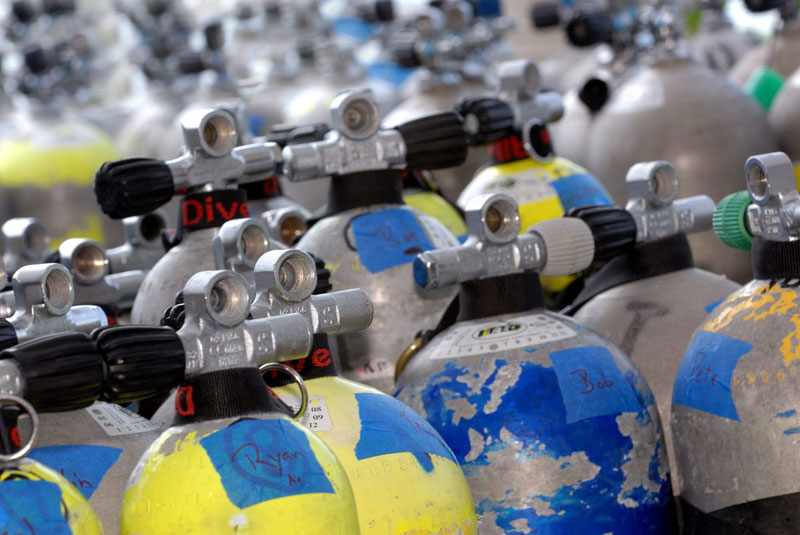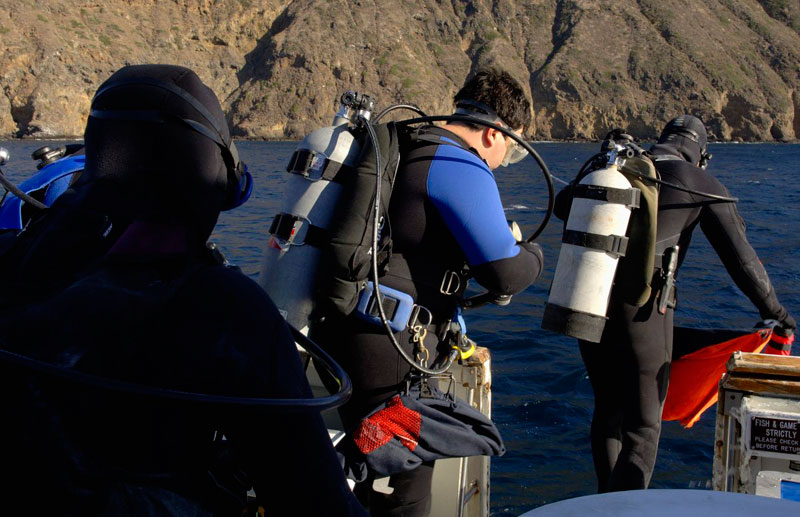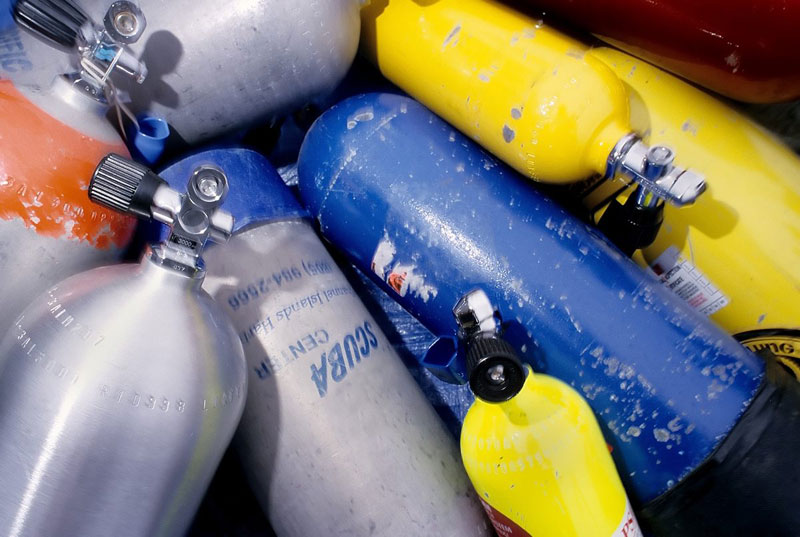 My morning dive was over and I’d just found a nice spot in the sun to sit down and enjoy my chocolate chip cookie, when two nearby divers erupted into a spirited debate: “Dude, what are you talking about? I’ve got 1800 psi and you got 1400 psi – of course I have more air.” His buddy responded, “ How many times do we have to go over this; your tank is an aluminum 80 and I have a steel 100, I’ve got more air.” With that, the first diver mumbled something inaudible then asked me where I got the cookie. After they left, I checked their cylinders and it turns out both divers were in error, because they were using incorrect assumptions. Although the first diver was ostensibly correct, he was using only the amount of pressure to make his decision, and the steel 100 diver was not taking into account the capacity of his cylinder at defined pressures. We will explore this in greater detail later.
My morning dive was over and I’d just found a nice spot in the sun to sit down and enjoy my chocolate chip cookie, when two nearby divers erupted into a spirited debate: “Dude, what are you talking about? I’ve got 1800 psi and you got 1400 psi – of course I have more air.” His buddy responded, “ How many times do we have to go over this; your tank is an aluminum 80 and I have a steel 100, I’ve got more air.” With that, the first diver mumbled something inaudible then asked me where I got the cookie. After they left, I checked their cylinders and it turns out both divers were in error, because they were using incorrect assumptions. Although the first diver was ostensibly correct, he was using only the amount of pressure to make his decision, and the steel 100 diver was not taking into account the capacity of his cylinder at defined pressures. We will explore this in greater detail later.
SCUBA training has without a doubt achieved a much better safety record, and allowed far more people to enjoy the underwater world then the early training of yesteryear. Unfortunately, over time, large amounts of “academics” have been phased out or simplified to the point of near uselessness. Therefore, it stands to reason that behind-the-scenes concepts like pressure/volume relationships and how to use them, could be confusing to many certified divers. Knowing what affects a SCUBA tank’s volume, and being able to predict air consumption rates, will go a long way toward making your diving more enjoyable. In this article we will explore some of these relationships, and try to clear up some of the misunderstandings surrounding them.
Pressure, at least in physics (I know….dirty word, but there is no math ahead, so please read on), is simply defined as a force exerted against an opposing body. The gas molecules within a diving cylinder are pressing against the walls with a particular force. The amount of force is dependant on a number of variables and for our purposes we can consider the following: How many (and type) of gas molecules are present; the amount of heat energy acting upon them, and the amount of space available to them. The last point is volume, which is basically the amount of space in three dimensions.
The volume of the SCUBA tank and the above parameters (pressure) will interact together to contain a defined amount of breathing gas. For example, the standard aluminum 80 cubic foot (cuft) tank will actually hold 77.4cuft of air at 3000 ponds per square inch (psi) at roughly room temperature. If either the temperature or pressure requirements are not met, the cylinder will not be at capacity. The temperature variable is a common problem when a tank is subjected to a “hot” fill (see sidebar). Hot fills occur when air is added to a cylinder too quickly. Because this causes excessive heat energy, the air molecules are bouncing off each other and the tank walls with more force than they would at a lower temperature. We would read this on a gauge as increased pressure; possibly thinking the tank was full. However, when the cylinder cooled down to room temperature, the gauge would read significantly less pressure. The air molecules would not be exerting as much force so they could fit closer together, effectively opening up space for more air. If the tank is not now “topped off” to its service pressure, it will not be full.
There are a bewildering number of different sizes of diving cylinders currently available. They come in a variety of capacities, lengths, diameters, and are made from either aluminum or steel. As we have already seen, it is a combination of pressure and physical dimensions that will determine how much air a SCUBA tank will hold. Both divers in the buddy team from the first paragraph based their conclusions on inaccurate assumptions. We have already seen that a “standard” aluminum 80 holds 77.4cuft at 3000 psi. The other diver’s tank was a steel high-pressure cylinder that will hold 100cuft at 3500 psi. We can take their ending pressures and determine who has more air remaining. Although there are several ways to calculate remaining volumes of air at a given pressure, we will use the concept of ratios (OK, I lied, we have to use a little math now, but it will be very simple). Ratios can be used whenever there is a linear relationship between the known and the unknown. For example, if 12 inches equals 1 foot, then 48 inches has to equal X feet. This can be expressed in the following format:
12in = 1ft
48in Xft
By cross-multiplying you get 12X = 48. Next divide both sides by 12 to isolate the unknown X:
12X = 48
12 12
X = 4 feet
Now, let’s look at the first diver’s remaining volume in his standard “80”. He had 1800psi left after the dive. Using the above ratio equation format we can say the following: If 3000psi will equal 77cuft (rounded off), then 1800psi must equal Xcuft with this cylinder. By putting it into a ratio equation we can solve for X:
3000psi = 77cuft
1800psi Xcuft
Next we cross multiply and we get 3000X = (1800)(77) or 3000X = 138,600
Now divide both sides by 3000 to isolate X:
3000X = 138,600
3000 3000
And we get X = 46cuft of air remaining
Now we do the same for the second diver’s 100cuft tank: With his tank we see that it has a working pressure of 3500psi instead of 3000psi, so it needs 3500psi
to bring the capacity to 100cuft. Therefore, the linear relationship between his starting pressure and ending pressure would look like this:
3500psi = 100cuft
1400psi X cuft
(Step1 cross multiply) 3500X = (100)(1400) or 3500X = 140,000;
(Step 2 divide both sides by 3500 to isolate X)
3500X = 140,000
3500 3500
This will isolate X and give the final answer X = 40cuft of air remaining
As it turns out, the first diver was indeed right that he had more air than his buddy, but only because he was lucky. If his buddy was using a “low pressure” 108cuft @ 2640psi, and they had the same ending pressures, then he would have been wrong. Plugging in the numbers will show the difference:
2640psi = 108cuft
1400psi Xcuft
(Step 1 multiply) 2640X = 151,200
(Step2 divide)
2640X = 151,200
2640 2640
Answer = 57cuft
Why the difference? By taking a look at Table One you can see that the steel 100 @ 3500psi cylinder is 7.25 inches in diameter and 24 inches long, while the steel 108 @ 2640psi tank is 8 inches in diameter and 26 inches long. Remember that the volume of air that a tank holds is a function of both the pressure and the internal dimensions. The higher pressure allows for smaller dimensions with the steel “100” and the increased dimensions on the steel “108” allow for an extra 8cuft and lower operating pressure. Now that we have a good handle on tank volumes and pressures, we can use this information to predict air consumption rates and how long a particular size cylinder might last us at depth.
Determining breathing rates is always an approximation because no two dives will ever be exactly the same. However, you can get a good idea about your average air consumption, and use this to make predictions on time available at any depth. The first thing you need to determine is your surface consumption rate (SCR). One way to do this would be to turn on your favorite half-hour television program, break out the tank and regulator and breath from the tank until the closing credits. Subtract the ending pressure from the beginning and divide by 30 minutes, and Viola you have your SCR. Of course, you need to live very near sea level, and make sure that you breathed only from the cylinder. A better way to do this then sitting on a sofa would be to maintain a set depth on your next dive and time it for ten minutes. This gives air consumption at the depth you used. It is then an easy matter to convert it to surface pressure (sorry, just a little more math).
If a whole atmosphere, say 33 feet, was used as the measurement depth, you only have to divide the breathing rate by two to get the SCR. For example:
After ten minutes, you consumed 600psi of air while maintaining a depth of 33 feet. To get the rate per minute you first divide 600psi by 10, which is 60psi per minute. This is the rate of consumption at 33 feet. Since 33 feet of seawater is equivalent to two atmospheres (ATM), and we want to know what the surface rate is, we simply divide 60psi/min by 2 to get an SCR of 30psi/min. We could use this number to determine what our breathing rate would be at any depth using ATM’s. If we did not use a “whole atmosphere” we can change the partial ATM into a fractional ATM. Let us say for a test dive we chose to glide along the wall at a depth of 60 feet for ten minutes monitoring our air consumption and we used 800psi. Divide 800psi by 10 minutes and we get 80psi/min.
We can now use the following formula to determine the fractional ATM:
Actual Depth + 33 Feet = ATM
33 Feet
Plugging in the numbers gives us:
60 Feet + 33 Feet = 2.8 ATM
33 Feet
For the SCR divide 80psi/min by 2.8 ATM
80psi/min = 28.6 or 29psi/min
2.8 ATM
By monitoring several dives with different conditions you can get a good idea on how much air you use while diving. This also allows much better pre dive planning because you will be able to predict air supply requirements even before getting wet. Let us now put everything we have just covered into a virtual dive and see what we come up with.
We have joined a dive charter boat that supplies tanks and weights. The cylinders are steel 78’s with a working pressure of 2400psi. Our own tanks at home are aluminum 80’s @ 3000psi. Today we will be diving the artificial wreck Yukon, off San Diego, at an average depth of 75 feet and we want a bottom time of 20 minutes. In order to plan the dive better, we need to decide if the different tanks are going to make a notable difference. We have chosen to ignore the difference in buoyancy characteristics as insignificant. The volume capacities are nearly identical, so we will be carrying essentially the same amount of total air. The major difference will be in deciding how much air is remaining at intermediate pressures. From a score of dives previously, we know our SCR to be about 28psi/min with our aluminum 80’s. Remember this would be our pressure used with an aluminum 3000psi “80”. Since we will be using a different cylinder on this dive we need to convert our SCR from pounds per square inch to cubic feet of air used per minute. This will allow us to use the figure for any size or type of tank. Using the linear ratio equation we can find out what 28psi is in cubic feet for our “80”
3000psi = 77cuft = 3000X = 2156 = X = 0.72cuft/min
28psi/min Xcuft
Our SCR is now converted from 28psi/min to 0.72cuft/min
Since the dive plan calls for a depth of 75 feet we need to find out what the fractional ATM is. Using the ATM formula:
Actual Depth + 33 Feet = ATM 75 + 33 Feet = 3.3 ATM
33 Feet 33 Feet
Now we multiply our SCRcuft/min with ATM:
3.3ATM x 0.72cuft/min = 2.4cuft/min used at 75 feet
All we have to do is multiply our intended bottom time of 20 minutes with 2.4cuft/min and we will have our estimated air consumption at depth. Therefore, we anticipate using 48cuft of air for this dive. So, our dive plan looks pretty good with roughly 30 cubic feet of air available for ascent and contingencies. We can also find our SCR in PSI for the new tank as well. Once again set up the linear ratio equation:
78cuft = 2400psi = 78X = 1728
0.72cuft/min Xpsi 78 78
The new SCR = 22psi/min
It is very important to keep in mind that these figures are all just estimates. Many factors enter into how much air we utilize. Everything from our current physical condition, how much air we use in our BC’s, time of descent, and use of regulator on the surface, all play a role in how much air we consume on a particular dive. This is why constant monitoring of the submersible pressure gauge is the only sure way to know how much air is actually remaining. However, being able to make these estimates will not only make a better dive plan, but will increase your confidence and dive knowledge as well. While some of the concepts may be a little confusing at first, with a little practice, you will be able to rattle off SCR’s, ATM’s, and PSI’s/min with the best of ‘em.
Words and photos by Joe Dovala. Visit Joe’s website by clicking here.
All content ©2014 and may not be reposted or reused without prior express written permission.



